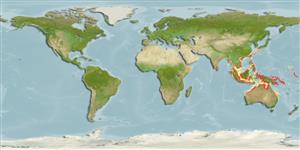Environment: milieu / climate zone / depth range / distribution range
Écologie
marin; saumâtre démersal. Tropical
Indo-West Pacific: South and southeast Asia, southern New Guinea and northern Australia.
Taille / Poids / Âge
Maturity: Lm ? range ? - ? cm
Max length : 50.0 cm TL mâle / non sexé; (Ref. 58022)
Épines dorsales (Total) : 1; Épines anales: 0; Rayons mous anaux: 14 - 21. Head depressed and elongate, 27 - 36% (mean 32%) of SL; exposed shield very striate or sharply granular. Narrow supraoccipital process, always keeled. Low set eyes. Small mouth, width 24 - 40% (mean 31%) of HL. Gill rakers absent on hind aspect of first 2 gill arches. Posterior epithelial ridges of palate run transversely. Caudal peduncle depth, 1.3 - 2.1 in its length (Ref. 38478).
Occurs in inshore waters over soft bottoms (Ref. 7300). Feeds on detritus, prawns, soft-bodied organisms, and mud (Ref. 38478).
Life cycle and mating behavior
Maturities | Reproduction | Spawnings | Egg(s) | Fecundities | Larves
Marceniuk, A.P. and N.A. Menezes, 2007. Systematics of the family Ariidae (Ostariophysi, Siluriformes), with a redefinition of the genera. Zootaxa 1416:1-126. (Ref. 58022)
Statut dans la liste rouge de l'IUCN (Ref. 130435)
Menace pour l'homme
Traumatogenic (Ref. 58010)
Utilisations par l'homme
Outils
Articles particuliers
Télécharger en XML
Sources Internet
Estimates based on models
Preferred temperature (Ref.
123201): 25.6 - 29.1, mean 28.3 °C (based on 1122 cells).
Phylogenetic diversity index (Ref.
82804): PD
50 = 0.5039 [Uniqueness, from 0.5 = low to 2.0 = high].
Bayesian length-weight: a=0.00525 (0.00269 - 0.01023), b=3.11 (2.94 - 3.28), in cm total length, based on LWR estimates for this (Sub)family-body shape (Ref.
93245).
Niveau trophique (Ref.
69278): 3.8 ±0.2 se; based on diet studies.
Résilience (Ref.
120179): Milieu, temps minimum de doublement de population : 1,4 à 4,4 années (Preliminary K or Fecundity.).
Fishing Vulnerability (Ref.
59153): Moderate vulnerability (40 of 100).
